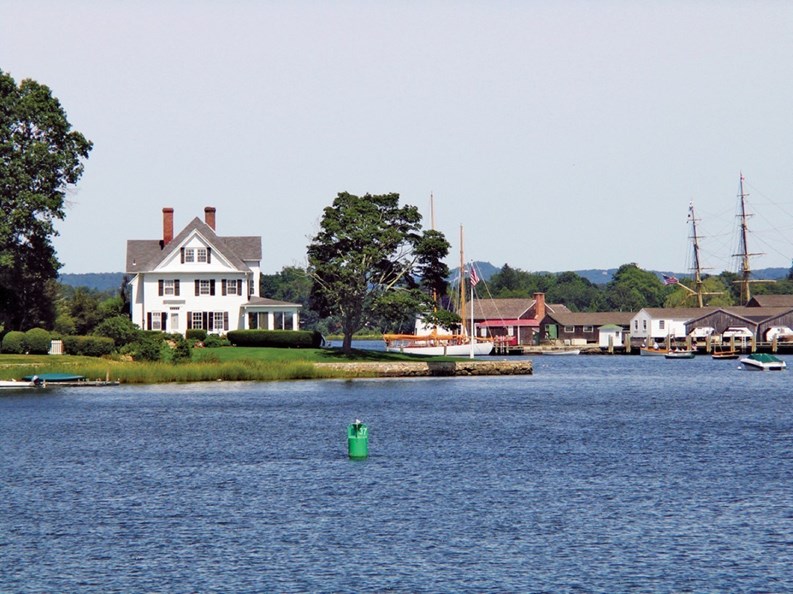From its rich maritime history to its hosting of the world’s largest living seafaring museum, Mystic, Connecticut’s natural connection to the sea has remained vibrant.
Divided by the Mystic River and lying in the neighboring towns of Groton and Stonington, Mystic is not a municipality, but a historic town that has been awarded a census-designated place (CDP) status based on its unique heritage.
That heritage, along with natural beauty and a picturesque harbor, attracts modern boaters, history buffs, tourists, and people who love the coastal life and boating lifestyles.
Half-way between New York City and Boston, Mystic enjoys natural coastal beauty along Long Island Sound. Though set apart, Mystic’s proximity to major coastal transportation arteries makes it a desirable place to live. Mystic is served by Amtrak rail service and major airports are in nearby Providence and Hartford.
Scenic and connected, Mystic offers the twin opportunities of escape and employment. To the east, Stonington is home to Mystic Aquarium and Institute for Exploration, and Mystic Seaport, a world class maritime museum; while to the west, Groton and New London on the Thames River draw many coastal residents for employment at the U.S. Naval Submarine Base, Electric Boat Corporation, or Pfizer Inc., contemporary major employers.
Tucked along the busy coast, residents of this area in southeastern Connecticut have made major efforts to preserve the jewels of their rich history.
One of those jewels is the Mystic Seaport. This “Museum of America and the Sea,” founded in 1929, highlights life on the Connecticut coast from a much older period. At the 19-acre maritime museum and heritage village, historical re-enactors – from oral historians and musicians to authentic craftspeople – bring the bygone coastal nineteenth century to life. The renowned maritime center includes exhibitions on maritime history and a special collections center, including maritime art and artifacts, ships’ registers, oral history recordings and videos, and photographs. The seaport’s Henry B. duPont Preservation Shipyard and its collection of wooden ships, such as the whaler Charles W. Morgan, further strengthen Mystic’s attachment to its coastal livelihood and heritage.
Educational Enrichment
In the hope of continuing that coastal tradition, educational facilities at the seaport provide enrichment for students of all ages. Adult classes on land range from traditional boat building to blacksmithing, focusing on tools and techniques from a bygone era.
Available on water are sailing lessons and safe power boat handling. Partner-ships in higher education aim to foster understanding of man’s connection to the oceans. The Williams College-Mystic Maritime Studies Program is a semester-long experiential learning undergraduate program taught at the museum. From the deck of a rigged ship, the program focuses on our relationship with the world’s oceans. Such educational opportunities through Mystic’s historical window engage the next generation’s relationship with the sea.
Mystic Aquarium and Institute for Exploration also fosters Mystic’s connection to the water. In addition to biological and ecological research and living marine life exhibits, the modern facility hosts other contemporary connections to the sea.
“Mystic Aquarium is just one of dozens of unique wedding destinations in this region,” Eileen McNamara recently reported in The Day, New London’s newspaper. The historic area provides interesting alternatives to the church-and-reception-hall combination, like being married among tuxedoed penguins or among the resident beluga whales. How’s that for a connection to the sea?
Mystic’s merger of history, ecology, and contemporary life lends it a certain prestige. Deb Chamberlain, a William Raveis real estate agent in Mystic, says, “Mystic has a real cachet to it.”
Shipbuilding and marine life exhibits aren’t Mystic’s only features connecting it to a seafaring heritage. Venues in nearby Groton attract tourists and residents alike. The first nuclear-powered submarine, the USS Nautilus, docks at the U.S. Navy Submarine Force Museum there. And in 1868, as ships transitioned from sail power to steam power, Connecticut gave 112 acres of land on the Thames River to the Navy in New London. Economically important to the area today, the Naval Submarine Base there employs 21,000 civilians, military, and military family members. The base is among the top five local employers, along with neighboring Electric Boat Corporation and the research campus of Pfizer Inc., in Groton.
The tribal-owned casinos Foxwoods and Mohegan Sun are other major employers in the area. They offer activities and entertainment for year-round residents and summer visitors. Mohegan Sun even hosts the Women’s National Basketball Association team, The Connecticut Sun. Golf and entertainment events at Foxwoods and in nearby Ledyard offer a different connection to the heritage of the area. The Native American-owned and operated gaming facilities bring a tandem pleasure to living or renting in Mystic. In a quiet coastal corner of Connecticut, the facilities provide a modern entertainment supplement to the lifestyle of Mystic’s downtown and historical seaport.
History Shaped by the Sea
Historical Mystic came to be after early skirmishes between native populations and early English settlers. The English king granted land near the Mystic River and other areas to veterans of the fighting. Early settlers survived on livestock and what plants they could grow in the stony coastal soil. In time, infrastructure and industry grew in connection to the colonists’ proximity to the sea. By the middle of the eighteenth century, shipyards operated along the Mystic River. Whaling and other bounties of the sea, fishing and trade, provided a prosperous boost.
According to Mystic Seaport, “Between 1784 and 1919 – the golden age of American maritime enterprise – more than 600 vessels were constructed along the Mystic River.” And in what is known as the clipper ship era, roughly a decade in the middle nineteenth century, Mystic-builtships brought goods from the colonial mainland’s major ports in Boston and New York as far as the West Indies and around South America to California gold rushers.
Much of the activity of modern day Mystic is dedicated to re-enacting that historical life for visitors. They come on buses, by car, by boat; they travel from New York City, Boston, and other locales further afield. They’re coming for that connection with the sea, but the historical connection doesn’t overshadow Mystic’s modern attraction.
“Most who come to live in Mystic are really looking for those boats and beach amenities,” Chamberlain says. “It’s a great place to live. It’s a lot of fun here. The water is just such a huge attraction. You can learn to kayak. You can do beach volleyball. You can do yoga on the beach at sunrise,” she says. “I think it really offers a fabulous combination of amenities for people who are looking to do the boating and the beach lifestyle.”
Tricia Cunningham, president of the Greater Mystic Chamber of Commerce, agrees: “The boating lifestyle is abundant in this area and several local marinas offer home-away-from-home amenities for boaters.” She notes that “dockominiums” – or marina boat slips– offer similar advantages as condos for boat owners. While year-round condominiums are available along the Mystic River and in Stonington and Groton, “many summer residents utilize the dockominiums as their summer homes,” Cunningham says.
As summer homes, many land-based condominiums offer the advantages of Mystic’s proximity to the water. Condominiums such as Randall’s Wharf in Mystic include a 29-slip marina and views and have sold from $345,000 to $1,175,000. The condo advantage in Mystic is similar to the dockominium advantage: visitors can come and have fun with Mystic’s combination of historic and modern amenities in the summer or all year long. “When you start talking three-, four-, five-hundred thousand for a condo and you’re looking at a more mature buyer, it’s typically because they don’t want the care [costs],” Chamberlain says. They want the combination of recreation opportunities and the ease that condo living provides, she says.
The area is also home to many fine restaurants. One of actress Julia Roberts’ earlier movies, Mystic Pizza, highlights this Zagat-rated Italian eatery and local favorite. Other Zagat-reviewed establishments include Zhang's and Bravo in Mystic, The Water Street Cafe in Stonington and Costello’s in nearby Noank.
Be it golf at the inland resort casinos or cruising the coast and Long Island Sound, Mystic offers much to the modern day visitor or resident. Chamberlain’s own children “spent their entire youth on the water and had a great time.” Mystic is living history. Its two-fold charm as a quaint coastal village and a bustling destination point blends its connection with the past and promise of the future. In Mystic’s dedication to its natural heritage, a life connected to the sea, it attracts the modern day people who love the water, boats, and coastal New England.
Schraepfer Harvey is a freelance writer living in Somerville, Massachusetts.







Leave a Comment